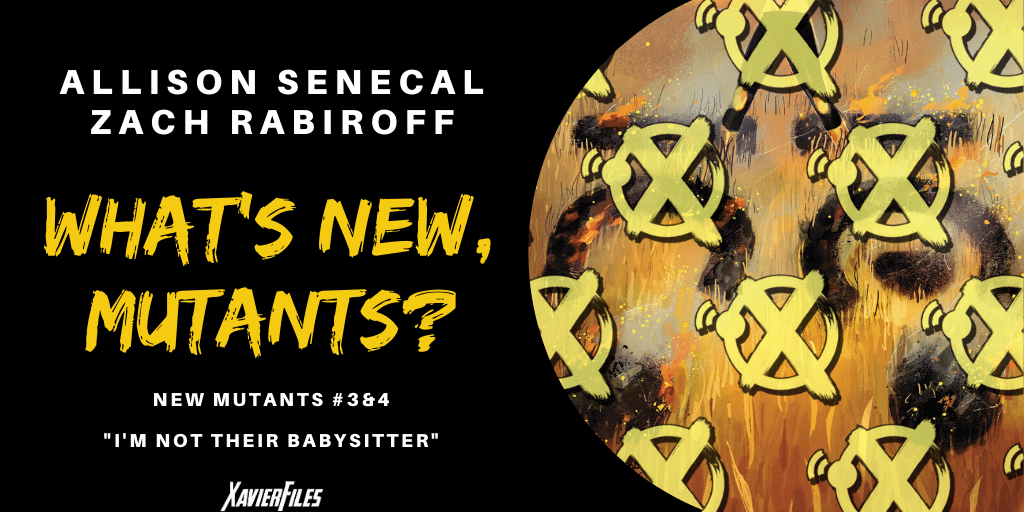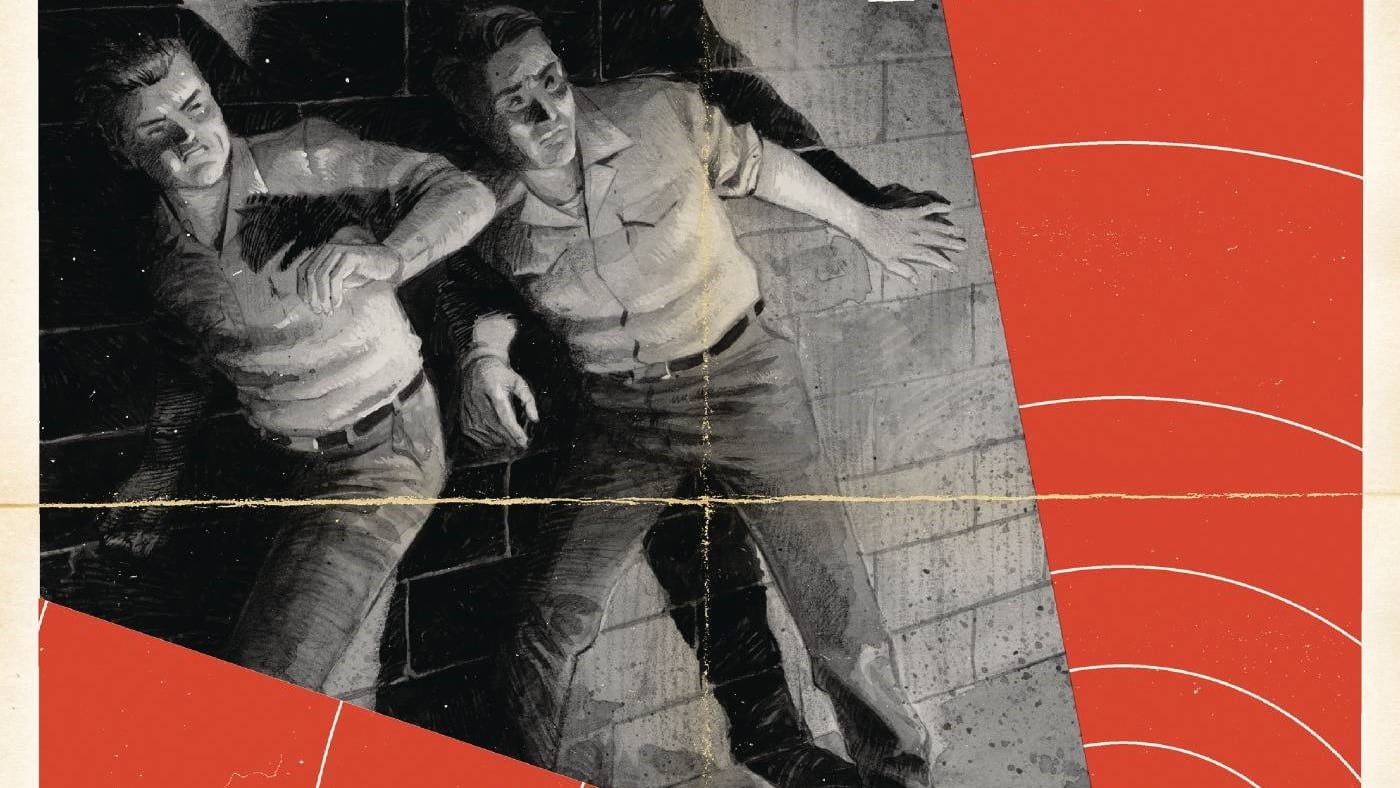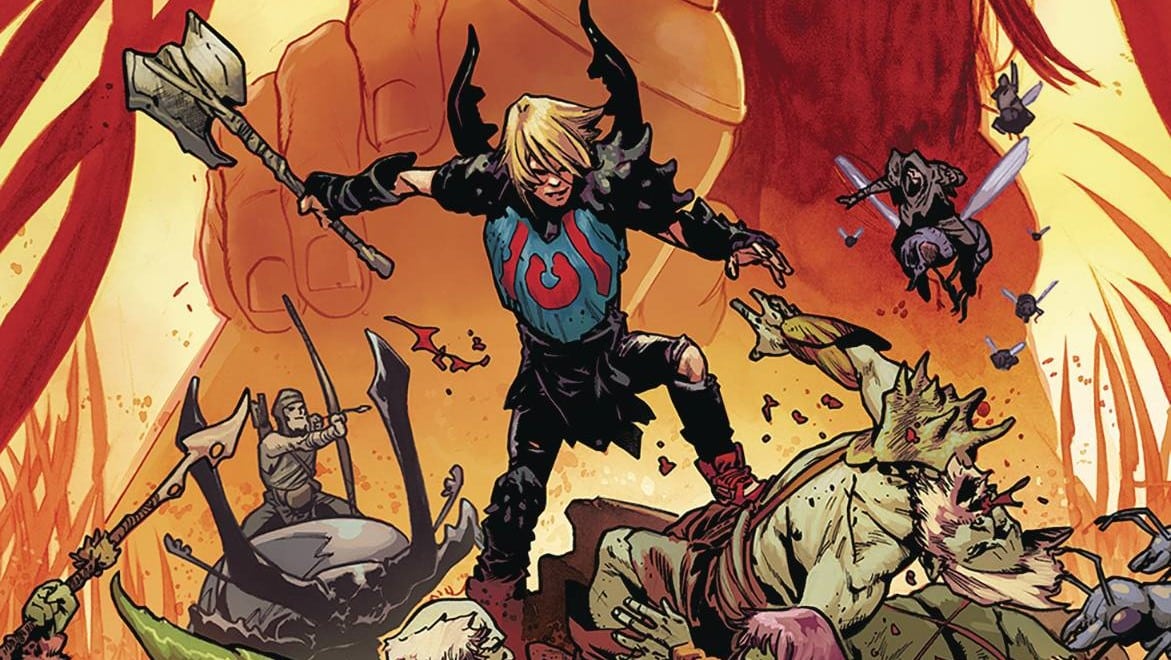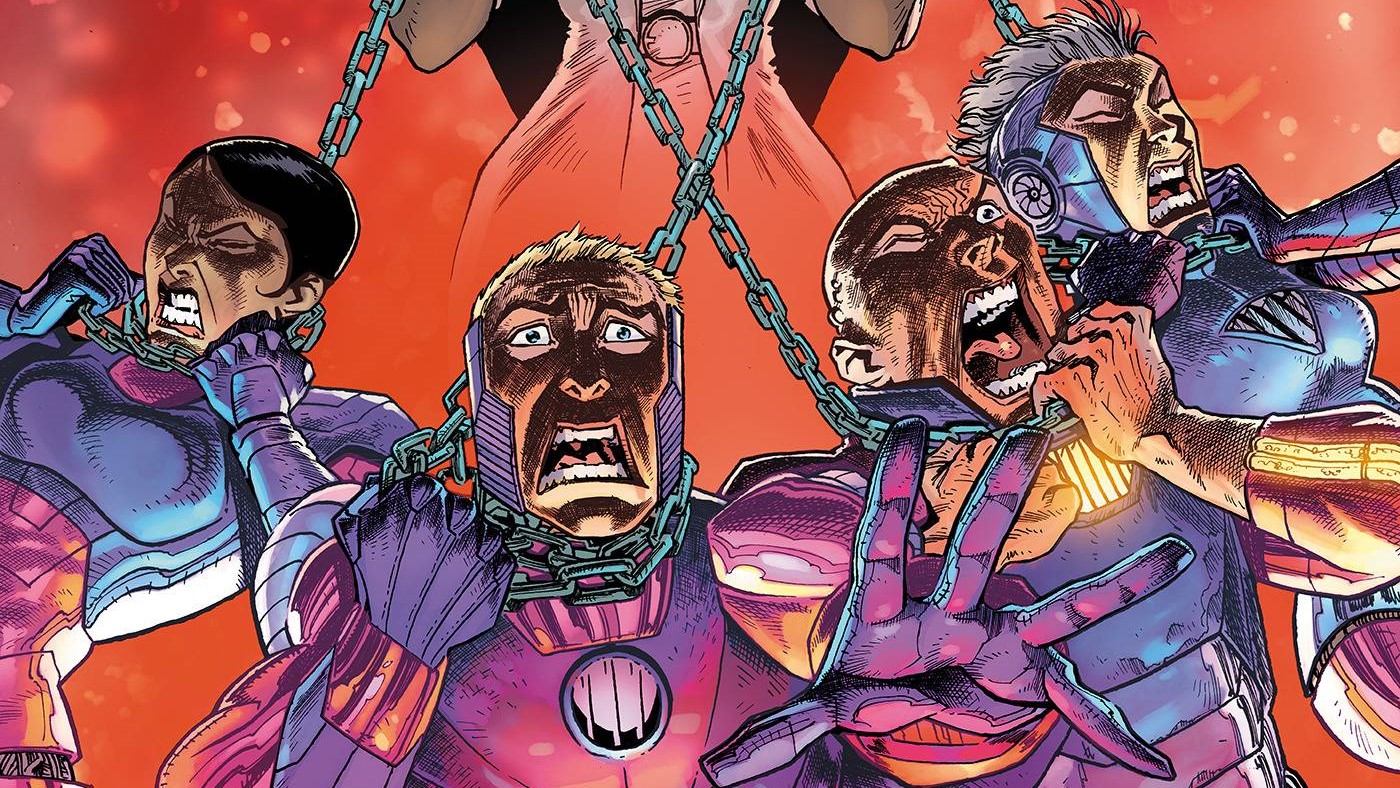Reveling in the paradise of Krakoa, Glob Herman and Armor question how any mutant could want to stay away. Inspired, they set off on an adventure to bring their friends Beak and Angel to the island. Unfortunately, in Ed Brisson, Flaviano, and Marco Failla’s New Mutants #3 & 4, their plan doesn’t go off without a hitch as they get caught in the chaos Xavier has caused in the world of black market pharmaceuticals.
Zach Rabiroff: Let me ask you a question: have you ever started eating a really good cone of chocolate ice cream? And then, a third of the way down, your tongue hits an unexpected flavor, and you realize to your horror that it was actually Neapolitan all along? And there’s nothing wrong with Neapolitan – strawberry can be very refreshing on a summer day! – but, damn it, you were really looking forward to that chocolate. Well, anyway: welcome to New Mutants #3 and 4, folks, the unexpected strawberry of the Dawn of X.
Allison Senecal: I like strawberry ice cream quite a bit…but, much like Boom Boom, I would rather be in space this month! On to Nextgen. I mean New Mutants. All-New All-Different New Mutants. There we go.
New New Mutants

ZR: Well, All-Different unless you’ve ever read an Ed Brisson comic, I guess, since we certainly find a number of that writer’s staples populating our roster here. But I think the comparison to Nextgen is a good one, and not just Armor and Brisson’s favorite see-through sad sack Glob Hermann are key players in both series. Looking back, I think we can see that portion of Age of X-Man as a kind of low-key setup for this lineup, similar to the way •┤Ȧ├•’s turn from villain to spiritual guru was foreshadowed in Apocalypse and the X-Tracts at the same time. And just as the paradise of Krakoa is an inverse of the twisted utopia that Nate Grey created, the motivation of this New Mutants team is turned on its head.
In Nextgen, it was about learning to become rebels against a society that was darker than it seemed. In New Mutants, it’s about living in a society that really is a paradise, to the point that Armor and co. feel compelled to gather in the wayward sheep, and bring everyone into the fold. In theory, it’s a really interesting, innovative idea. In practice…well, I guess that’s what we’re here to discuss.
AS: Yeah, as soon as I saw this cast I figured we’d been in for at least some play off the Nextgen themes. Fortunately, this core cast is Brisson’s strong point and he’s paired with two fun artists here in Flaviano and Failla. I love how expressive their Boom Boom is and you can tell Brisson is still having a good time writing her. I know she was a favorite of his during his X-Force run. I’m delighted Armor is still getting some time in the spotlight (and in a leadership role again), post-Age of X-Man. I guess the M&M twins also exist. Again. They remain the creepy little maladjusted children of the corn here (albeit very useful children of the corn in issue 4). It’ll be nice to see their powers put to more interesting uses in the new status quo. And Glob was at least somewhat pitifully charming in these two issues. I can see how he’s some folks’ Very Good Boy. That’s all I’ll give him! [Ed. note: You’ll come around eventually.]
I know a few fans have been weirded out by the overwhelmingly positive vibes we’ve seen so far in some titles, but this isn’t a title where I take issue with it. These are the X-Kids. They’ve seen some $%@#. They want to be happy and be able to enjoy their friends. I think overall that sentiment is pretty lovely. Maybe I’m just a sap this month.
ZR: I agree, and I’d add that while it takes Brisson some time to find his voicing for the young cast (a little surprising, frankly, considering how often he’s written some of them already), by the end of this second week, I think he’s really gotten them down flat. Take Boom Boom, for example [Ed. note: Please don’t actually take Boom Boom, we love her]. Our dear Tabitha ought to be the most interesting, scene-stealing character in any comic she’s in. She once picked a lock with her feet while making out with Cannonball at the same time! She stuck a bomb down Fin Fang Foom’s underpants! This is a get out of jail free card for any comic writer if ever there was one.
While I had some concerns about an odd flatness in her dialogue after Brisson’s first week, issue #4 was an absolute showcase of delightful Tabitha Smith antics. Self-pityingly partying the night away with Pixie, engaging in hilariously condescending patter with Sage: it all just feels absolutely right. And underneath it all is an undercurrent of poignant, unspoken loneliness. Not quite an old-school New Mutant, and basically a senior citizen to kids like Armor and Pixie, she’s got no clique to call her own anymore. Like her fellow X-Factor wards Skids Blevins and Rusty “Have I Been Resurrected Yet” Collins, she’s alone in the mutant crowd. And I think that kind of quiet but nuanced understanding of these kids is really Brisson’s major strength as a writer, even when his plots aren’t earth-shatteringly engaging.
I’m also a big fan of Flaviano and Failla’s line work here, which is a startling and very effective counterpoint to Rod Reis’s work on the other half of this series. While Reis channels the weirdo, angular, Siekiewicz vibe of old-school New Mutants, Flaviano’s curvy lines and thick inks bring a lighthearted Mike Allred flavor to the proceedings, which Carlos Lopez’s bright color palette brings out even more. Art-wise, I dug it.
AS: I for sure agree about the story. It’s just…there. Motoring along, but not in a particularly interesting way, even after finding out the villains’ true motivations. But I disagree on the character work. I think it’s there. I just think the narrative strength (or lack thereof) is what’s dampening it or making it feel lacklustre. Essentially issue 3 managed to meet my expectations which were uh, quite low. It was fine but it’s on the too-safe end of the spectrum for me. #4 is much stronger across the board, and agreed on Tabitha. She really shines.
ZR: And, hey, comics could be worse than that, right? In full credit to Brisson, I think the way he’s setting up Armor as a leader here is a great move, and one that builds on the character’s development ever since she was introduced in Whedon’s Astonishing run. When we first met Armor, she was a callow, slightly over-her-head freshman at Xavier’s school with a lot of unlearned potential. Over the years, we’ve watched her gain experience, confidence, and a sense of leadership and obligation toward her entire generation of mutants, so her interest in the fate of missing teammates makes a lot of sense here. It’s a character progression that’s reminiscent of her predecessor Kate Pryde, and Brisson’s work with her over the years is a big part of that.
AS: Let me just butt in to say I’m not sure anyone in Dawn of X is more relatable than Kate and Tabby right now.
Our House, In The Middle Of The Street

ZR: Also in the category of character relationships is our first, fascinating data page all about the setup of the Akademos Habitat, where the younger generation of Krakoans lives and (in theory, anyway) learns. For one thing, we get a breakdown of the various collegiate and/or frat houses for our mutant groups, which are apparently divided along the lines of young mutant teams past. DELTA House, for instance, is home to my beloved Generation X gang [Ed. note: presumably being kept under double secret probation — fat, drunk, and stupid is no way to go through life, Mondo]. BETA House is the home base for the Frost Academy, which I suppose is the new name for the old Hellions of Massachusetts now that they’ve been uprooted from their New England home base. And OMEGA House is yet another bit of redacted mystery text in these data pages. What on earth is that all about, do you think?
AS: My gut reaction was that the OMEGA House housed the OG Hellions, seeing as the New Mutants are in ALPHA, but yeah, they gotta be the Frost Academy. I honestly have no other strong (see: not strong at all, entirely kidding) guess besides that being Quire’s private villa since no one wants to room with him and I can not imagine him teaching anyone anything. Tin-foil hat theory is it could be a place for younger Omega level mutants? That seems too on the nose, but if they are actively seeking out Franklin in a few months…maybe? That said, three of them are members of the Five and they have their own place. Any other glaring omissions from the younger generations? I really can not think of anyone.
ZR: My personal theory is that OMEGA House is where Sinister keeps his untrained horde of baby Havoks, but I’m keeping that theory close to the vest. The other thing that caught my eye about this page was the description of Akademos as a place where “young mutants exchange ideas and learn from one another, forgoing classroom studies and student/teacher relationships. All are students, all are teachers.” Much like my decision to take multivariable calculus in college even though I was an English major, this seems like one of those educational ideas that looks great on paper, but is an absolute catastrophe in practice. [Ed. note: As was my decision to literally take rocket science as an elective in my last, allegedly relaxing, semester.]
On the one hand, I see what the creators (and, by extension, Xavier) are going for. Krakoa is a new society, free from human rules and expectations, and they should have an educational system as revolutionary as their lives and government. The model here (as the name suggests) is the Grove of Academe outside of ancient Athens, where Plato and his philosophical companions strolled pleasantly to engage in Socratic dialogues and invent proto-totalitarian government systems. It’s a lovely, pastoral image, until you remember that just one issue ago Illyana Rasputina, proud graduate of the Xavier School of Hard Knocks and Demonic Enchantment, was happily admitting to functional illiteracy. I’d say they ought to recruit a real headmaster after all, but alas, all the qualified applicants are busy being self-consciously moral capitalists, pirate captains, reformed terrorists, savage killing machines, and metal-hat-wearing political figureheads respectively.
In any event, we don’t get to spend much time in the groves of Akademos, because the mutants are off to the ostensible plot of our story: finding their erstwhile teammate Beak, and saving his terminally ill father with the aid of Krakoan miracle drugs. What did you think of this portion of the issue? Did the happy reunion tug at your heart strings?
AS: Kind of? I really don’t care for Brisson’s Angel (my only glaring criticism of his work on this cast) and I can’t quite put my finger on it. I just found her much more mild and flat than I was expecting upon seeing her again. The Hisako hug, though, I did get a little emo. Her move to release Manon & Maxime was an improvement in the following issue, too. No way she takes that situation complacently, even with her kids in danger.
Did the Krakoan drugs work too quickly to you? I know we gotta keep it moving for the plot, but I figured we’d just see Beak’s dad resting comfortably and then get an update on his health in a few issues. Ah well, comic books.I’m not sure if I would call the whole sequence anti-climactic exactly, but for the first use we’ve seen of the miracle drugs, I expected a bit more. Though, the drugs working on a mystery disease was a pretty decent indicator of just how powerful they are, I suppose.
ZR: I totally agree about Angel Salvadore, whose homebody persona here is a far cry from the sparkplug we first met in Grant Morrison’s New X-Men. There, she was emblematic of the cool, aggressive rebellion of the young mutant generation, and there’s a depressing moral to be drawn here about the capacity of parenthood to defang youthful idealism. But while I can’t say I’m wild about Angel’s transition from unabashed superhero to humble housemom, I’ll give Brisson credit and note that this is very much the way she was written during her appearances in the 2007 New Warriors series — so to some extent, he’s playing the continuity cards he was dealt. [Ed. note: It would be better if we all forget that run happened.]
I also think that the miracle drug sequence fell a little bit flat. This should have been the key emotional beat of issue #3, letting us see the human impact of Krakoan science on the lives of real people we know. Instead, it felt altogether rushed, with no time devoted either to introducing us to this man or his relationship to Beak, or to showing the impact his salvation had on him or his family. It’s the flip-side of the big, beautiful panels Flaviano and Brisson are using to tell their story: in a 20-page issue, it just doesn’t pack in enough storytelling to really get these kinds of satisfying emotional moments across. And to be honest, I had similar issues with the fight scene that closes out this issue on a cliffhanger.
AS: I also didn’t really care for the way #3 ended. Power-dampening missiles? Another villain group getting introduced? Just an unneeded action sequence. This would have done just fine as a quiet issue with the conflict coming from the situation with Beak’s dad, and whether or not he and Angel are bringing the kids to Krakoa. Instead of wanting to see what happens in the next issue, I was ho-hum “Oh really? Right now?” about the whole hostage situation. After reading #4, we know this was a set-up to introduce some other players in the Big Pharma game but to me, it just wasn’t compelling on its own.
Rx-Men

ZR: I’m of two minds with this Big (and pink, and muscular) Pharma plot. On the one hand, I’m glad to see Brisson really leaning into the new Krakoan status quo by taking on some of the meaty geopolitical topics that were opened up toward the end of HoXPoX. Specifically, this issue starts to explore the iffy implications of access to mutant miracle drugs, and adds in the additional wrinkle of exploitative American pharmaceutical companies [Ed. note: The fictitious Kevin MacKinnon, said here to have been murdered by our mutant-hostage-taking villains, is pretty clearly inspired by real-life douchenozzle and ex-Pfizer CEO Martin Shkrelli]. All of this is very good, and very interesting.
Yet at the same time, I can’t help but feel that Brisson sidles right up to the edge of political subject matter, but can’t quite cross the line. Part of the issue is that, in order to clearly and cleanly establish these thugs as villains, he sets them up as profiteering pharma lords in their own right, out to turn a quick buck off their dying populace, and unapologetic about killing mutant teenagers to get their way. As a result, intentionally or not, we’re never really encouraged to take their position seriously, and neither are the mutants themselves. Imagine if, instead of thuggish terrorists, these guys were average, suffering Costa Perditans, desperate to get access to Krakoan medicine at whatever cost. Would the young heroes be so quick to decide they were the bad guys? Might they even sympathize with them over the Charles Xaviers of the world?
Likewise, I think Brisson is much too quick to let Krakoa itself off the hook here. Yes, all Costa Perdita has to do is recognize Krakoan sovereignty in order to get trade access. But be that as it may, the mutants really are out to turn a profit — it’s the whole basis for the Hellfire Trading Marauders, after all, and those spiffy three-piece suits Xavier wears to complement his Cerebro helmets don’t just grow on trees. Or, rather, they do in this case. I, uh, seem to have lost the thread here. But my point is, there’s a lot of nuance and ambiguity here that the issue doesn’t really work to explore, and I wish Brisson had done more than just scratch the surface. Nevertheless, it’s a good start.
AS: I think it’s pretty safe to say this group of kids would 100% sympathize with Costa Perdita civilians if they were introduced or mentioned here in any capacity. I mean just recently, this is the team that pushed back against Nate Grey’s status quo in Age of X-Men. I can’t imagine them blindly accepting the drug distribution laws if faced with sick kids. You could ask “what have humans ever done for mutant kids?” and I could see someone like Magneto taking that stance, but not Glob or Armor. Our Boomer also isn’t one to just go with the flow.
That said, this seems almost like it should be an incoming plot point, so maybe we’ll see Brisson explore it? That or we’ll breeze by it here, but get it in Marauders. It would seem like a waste of this cast to not visit that, but hey, this interlude isn’t big on narrative intrigue so far, so.
I know I said earlier I’m good with these kids being idealistic when it comes to the new status quo, but now I’m like “damn!” Let me change my mind about these issues twenty times.
ZR: Truth be told, the nuts and bolts of the plot continue to be the weak point of Brisson’s writing, really a distraction from the engaging character work that he (and we) are just waiting to get back to. Just as the somewhat perfunctory one-panel fight in issue #3 was the least essential moment of that story, the mutant breakout sequence in issue #4 is like a master class in generic comic book action: the terrorists actually fall for the old “just take off my mutant inhibiting collar, I promise I’m not planning to spit acidic digestive juices over the chains of my teammates” trick! Thankfully, it all turns out to be in the service of deeper characterization, as the Pasty Twins engage in some potentially murderous mental manipulation, and Boom Boom arrives to save the day and throw in with some new friends.
So, did I think these issues succeeded as the debut of our earthbound New Mutants team? Well, yes and no. I thought the execution was rocky on a few levels, and the plot feels a bit factory-produced in a way that the more ambitious Dawn of X titles haven’t. But at the same time, I do think that Brisson genuinely cares about this quirky group of kids, and I’ve been saying all along that the X-Men line was badly in need of a book to focus on the human element of mutant life. Given time and space to find its footing, I think this book can work, even if it’s never going to have the kind of wild scope that Hickman is bringing to his half of the title.
AS: I was very much looking forward to the Xavier’s Witnesses vibe the cover and solicits for these issues initially teased. Door-to-door young mutant outreach! You’re a young mutant. Why aren’t you going to Krakoa? I could see all kinds of scenarios. Human parents, obviously, but also worries about fitting in or what kinds of mutants are allowed in Krakoa. We know it’s all mutants so long as you uphold the laws, but I can see teen mutants being concerned or not knowing how to reach out. Enter seriously empathetic X-Kids, Armor and Glob! And give us more of Mutant Reddit! Lean into it being the school, er…educational collective, book. Brisson really does write this bunch so warmly that I want to see him taking them through more quiet moments. I hope we get there after this more action-packed opening arc.
My biggest peeve when I’m reading reviews is people saying what they wish a book or comic was instead of critiquing what it is, but with the new Krakoan nation, it’s tough to not feel like we could be going certain deeper directions with these books. I’m absolutely criticizing myself on this, but still.
Still not feeling the way this series is split either, but hey, we’re in the thick of it now, and I’m feeling much better in general about it than I was. I’ve changed my mind so many times about these issues. Eager to see where Brisson takes us, but he can wait until after…DEATHBIRD.
X-Traneous Thoughts

- Ugh. Nebraska.
- I’m honestly still not sure what connective tissue unites this with the Hickman half of New Mutants, except the extremely general theme of “people under 25.” It seems like a slightly odd way to smush two miniseries together, in a way that lets this one piggyback on its spacefaring cousin.
- Sage absolutely having no time for Boom Boom is what I want more of
- The Krakoan for next issue reads: Commando
- Make sure to check out this week’s coverage of Fallen Angels #4, X-Force #4, Marauders #4, and Excalibur #4
Allison Senecal buys books professionally and comics unprofessionally.
Zach Rabiroff works daily at a charity, and is also a freelance writer and editor. He reads a lot of comics.







